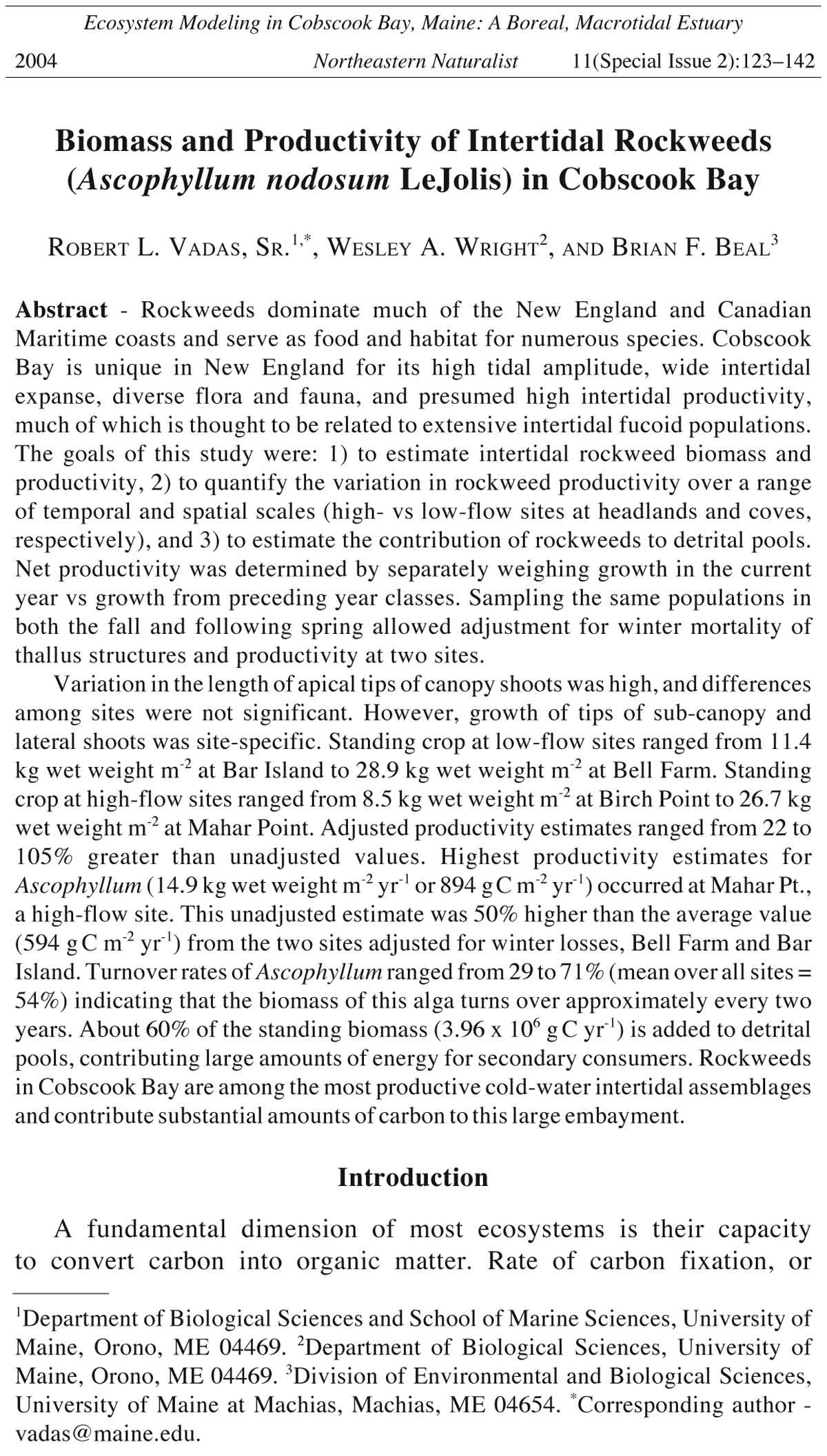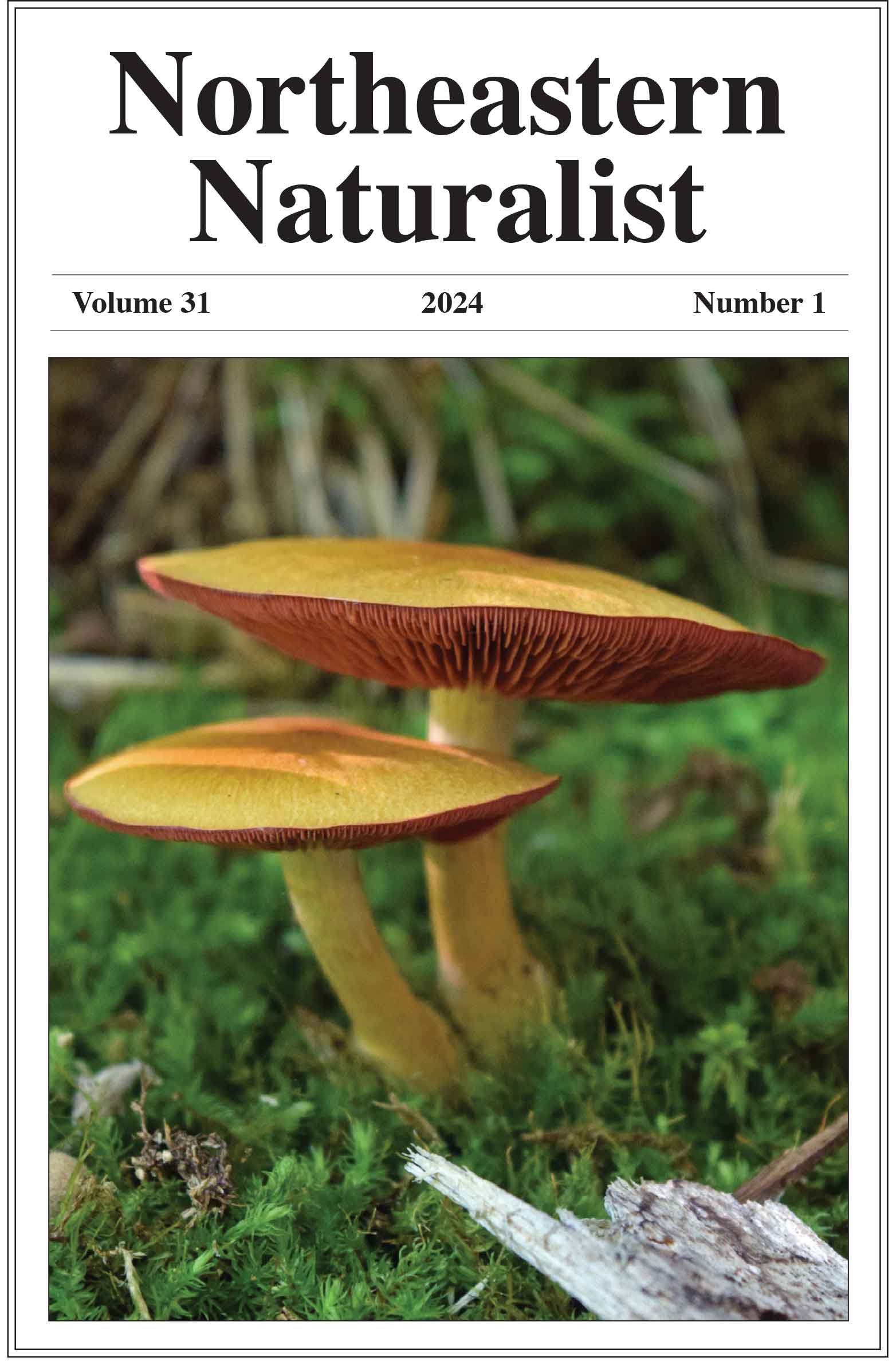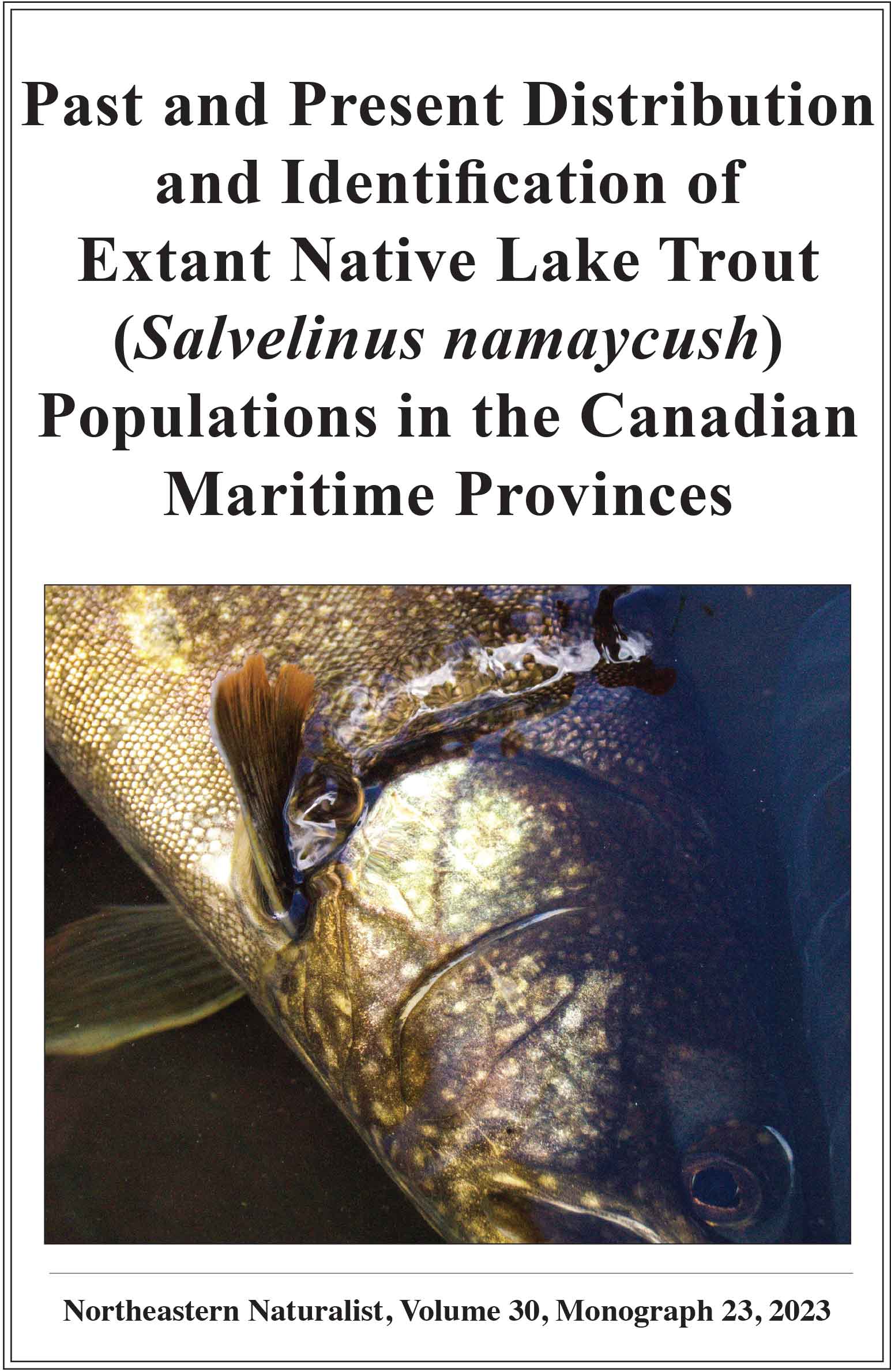Ecosystem Modeling in Cobscook Bay, Maine: A Boreal, Macrotidal Estuary
2004 Northeastern Naturalist 11(Special Issue 2):123–142
Biomass and Productivity of Intertidal Rockweeds
(Ascophyllum nodosum LeJolis) in Cobscook Bay
ROBERT L. VADAS, SR.1,*, WESLEY A. WRIGHT2, AND BRIAN F. BEAL3
Abstract - Rockweeds dominate much of the New England and Canadian
Maritime coasts and serve as food and habitat for numerous species. Cobscook
Bay is unique in New England for its high tidal amplitude, wide intertidal
expanse, diverse flora and fauna, and presumed high intertidal productivity,
much of which is thought to be related to extensive intertidal fucoid populations.
The goals of this study were: 1) to estimate intertidal rockweed biomass and
productivity, 2) to quantify the variation in rockweed productivity over a range
of temporal and spatial scales (high- vs low-flow sites at headlands and coves,
respectively), and 3) to estimate the contribution of rockweeds to detrital pools.
Net productivity was determined by separately weighing growth in the current
year vs growth from preceding year classes. Sampling the same populations in
both the fall and following spring allowed adjustment for winter mortality of
thallus structures and productivity at two sites.
Variation in the length of apical tips of canopy shoots was high, and differences
among sites were not significant. However, growth of tips of sub-canopy and
lateral shoots was site-specific. Standing crop at low-flow sites ranged from 11.4
kg wet weight m-2 at Bar Island to 28.9 kg wet weight m-2 at Bell Farm. Standing
crop at high-flow sites ranged from 8.5 kg wet weight m-2 at Birch Point to 26.7 kg
wet weight m-2 at Mahar Point. Adjusted productivity estimates ranged from 22 to
105% greater than unadjusted values. Highest productivity estimates for
Ascophyllum (14.9 kg wet weight m-2 yr-1 or 894 g C m-2 yr-1) occurred at Mahar Pt.,
a high-flow site. This unadjusted estimate was 50% higher than the average value
(594 g C m-2 yr-1) from the two sites adjusted for winter losses, Bell Farm and Bar
Island. Turnover rates of Ascophyllum ranged from 29 to 71% (mean over all sites =
54%) indicating that the biomass of this alga turns over approximately every two
years. About 60% of the standing biomass (3.96 x 106 g C yr-1) is added to detrital
pools, contributing large amounts of energy for secondary consumers. Rockweeds
in Cobscook Bay are among the most productive cold-water intertidal assemblages
and contribute substantial amounts of carbon to this large embayment.
Introduction
A fundamental dimension of most ecosystems is their capacity
to convert carbon into organic matter. Rate of carbon fixation, or
1Department of Biological Sciences and School of Marine Sciences, University of
Maine, Orono, ME 04469. 2Department of Biological Sciences, University of
Maine, Orono, ME 04469. 3Division of Environmental and Biological Sciences,
University of Maine at Machias, Machias, ME 04654. *Corresponding author -
vadas@maine.edu.
124 Northeastern Naturalist Vol. 11, Special Issue 2
productivity, and available organic matter are the key components that
drive the trophic linkages of a community or ecosystem (Whittaker
1970). In most aquatic communities, macrophytes and phytoplankters
are responsible for primary production. In boreal-temperate marine ecosystems,
macroalgae and seagrasses comprise two potentially important
benthic groups that contribute substantial amounts of carbon to
nearshore communities (Mann 1973). Macroalgae take the form of algal
filaments, simple corticated or foliose thalli, encrusting fleshy or calcified
crusts, and complex and massive rockweeds and kelps. Early
studies and syntheses (Kanwisher 1966) suggested that productivity was
inversely related to thallus size or mass (see also Littler and Littler
1980, Steneck and Dethier 1994, Vadas 1979). However, convergence
of thallus forms does not necessarily dictate similarity of metabolic
function (Dudgeon et al. 1995).
Relatively slow-growing rockweeds, such as Ascophyllum nodosum
Le Jol. and Fucus vesiculosus L., dominate the New England and Canadian
Maritime coasts (Sharp and Semple 1990, Vadas and Elner 1992).
These algae are conspicuous throughout North Atlantic shores (Baardseth
1970, Stengel and Dring 1997), and are present in both high and low-flow
velocity habitats (Hardwick-Witman and Mathieson 1983). On many
shores, they dominate the entire vertical gradient. Ascophyllum is abundant
on moderately exposed and sheltered shores (Keser et al. 1981;
Topinka et al. 1981; Vadas and Wright 1986; Vadas et al. 1976, 1978) and
often forms a monoculture (sensu Paine 1984) on Maine shores. Both
species provide valuable habitat and are important sources of food for
several food webs in coastal ecosystems. Because of their height,
branched structure, and mass, they serve as nursery areas or habitat
during both low and high tide for numerous sessile and mobile organisms
including algae, invertebrates, and larval and juvenile fish (Bertness et al.
1999; Fegley 2001; Mathieson et al. 1976; Menge 1978; Rangeley and
Kramer 1995a,b). Rockweed beds are also important foraging areas for
wildfowl (Hamilton 2000). Clearly, understanding what controls the
abundance and productivity of fucoids, especially Ascophyllum nodosum,
is important at several trophic and functional levels.
A number of methods exist to assess biomass and production in the
field, however, most are destructive or indirect estimates. Destructive
harvest measurements are typically used in Ascophyllum assessment
(Baardseth 1970, Keser et al. 1981), but non-destructive measurements
of changes in the length of apical branches have also been employed for
growth (MacFarlane 1932; Stengel and Dring 1997; Vadas et al. 1976,
1978). Also, the length and slopes of site-index curves have been used to
estimate growth and production in Ascophyllum (Vadas and Wright
1986). Bundled volumes of small patches of Ascophyllum have been
used as a non-destructive predictor of biomass and productivity in the
2004 R.L. Vadas, Sr., W.A. Wright, and B.F. Beal 125
field (Aberg 1990, Cousens 1984). We developed a modified version of
the volume technique to rapidly predict biomass in the field. Our field
sampling procedures (below) were designed for estimating volume, but
here we report on only the wet weight analyses. A detailed study on the
volumetric technique will appear elsewhere (Wright et al., in prep.).
The overall goal of the present study was to estimate intertidal
biomass and productivity in several locations and establish a temporal
baseline for Ascophyllum growth and productivity in Cobscook Bay. A
secondary consideration was to quantify the variation in net productivity
of Ascophyllum over a range of temporal and spatial scales. Selection
of study sites reflects the spatial variability in hydrodynamic regimes at
headlands and coves (high- vs low-flow sites). Because of its dominance
intertidally, Ascophyllum was used to estimate the contribution of fucoid
algae to the biomass and productivity of Cobscook Bay.
Study Sites and Methods
Sites, field collections, and general measurements
Ascophyllum was sampled at headlands (high-flow) and coves (lowflow)
at five intertidal sites in Cobscook Bay in 1995 and 1996 (Fig. 1).
Two low-flow sites in Whiting Bay (Bar Island and Bell Farm) and one
high-flow site in the Central, or South, Bay (Garnet Point) were sampled
in October 1995, following the termination of vegetative growth (Vadas
et al. 1976). Two additional high-flow sites, Birch Point in South Bay
and Mahar Point in Inner Bay (Denny’s Bay), were sampled in May
1996 prior to gamete release. Our choice of sampling times was designed
to occur after the completion of annual vegetative growth (fall)
and before the release of gametes and the dehiscence of receptacles in
the spring. To estimate overwintering losses of both vegetative and
reproductive tissues, Bar Island and Bell Farm were sampled during
both winter and spring, which resulted in a refined (adjusted) estimate of
productivity.
All analyses were based on haphazardly tossed 10-cm x 10-cm
quadrats in the mid-intertidal, near the mid-range and most productive
region (Stengel and Dring 1997) of the Ascophyllum band. Quadrat size
was based, in part, on the ability to determine readily the circumference
of the bundled thalli, and thereby the volume of Ascophyllum within the
same quadrat (cf., Aberg 1990, Cousens 1984). Samples were taken
during low tide until twenty quadrats containing Ascophyllum were
recorded. Total number of tosses at each site was recorded so that null
quadrats would be included in standing crop estimates. All Ascophyllum
thalli within each of the 20 quadrats were scraped from the substrate,
bagged, wet weighed, labeled, stored on ice, and transported in coolers
to the laboratory.
126 Northeastern Naturalist Vol. 11, Special Issue 2
In the laboratory, samples were placed in a strainer and rinsed in tap
water, and all epiphytes, rocks, and sediment attached to holdfasts
removed. The number of holdfasts per quadrat was recorded and the
longest thallus was used to determine maximum length. When possible,
the longest unbroken thallus was used to estimate the minimum age of
thalli in each sample by counting the annually produced air bladders
along the main axis from the distal tip to the holdfast. An extra year was
added to each age count because the segment from the holdfast to first
bladder is conservatively estimated to be two years old (Keser and
Larson 1984a; Vadas and Wright, unpubl. data). The sample was blotted
dry with paper towels and the total wet weight recorded.
To distinguish between the current and previous year’s vegetative
growth (and contribution to annual productivity), growing tips were
Figure 1. Map of Cobscook Bay rockweed study sites during 1995–96. BF = Bell
Farm, BI = Bar Island, BP = Birch Point, GP = Garnet Point, MP = Mahar Point.
2004 R.L. Vadas, Sr., W.A. Wright, and B.F. Beal 127
excised directly below the most distal air bladder. Air bladders are
initiated annually in spring, and provide a convenient marker for annual
growth. Excised apical tips sampled during fall represented annual
linear vegetative growth during 1995. Because thalli sampled in
(March–April, 1996) had recently formed an additional air bladder and
the vegetative growth of interest occurred in 1995, shoots were cut in
two places, immediately below the first and below the second most
distal bladders. The second (lowermost) segment represented linear
vegetative growth during 1995. Growth of Ascophyllum tips is affected
by shading, and the vertical position of the growing tips in the canopy or
understory determines length (Cousens 1981, Vadas and Wright 1986).
Apical or distil tips (segments) representing 1995 growth were categorized
as canopy, subcanopy, or suppressed tips. Apical tips on the
longest thalli, e.g., shoots not shaded by Ascophyllum thalli, were defined
as canopy tips. Tips on shoots that were 50 to 80 percent of the
length of canopy shoots and at least partially shaded by the canopy were
defined as subcanopy tips. Tips on shoots that were shaded and were
shorter than 50 percent of the length of canopy shoots were defined as
suppressed tips. Short lateral branches within the subcanopy or understory
were also classified as suppressed tips.
Up to twenty-five 1995 growth segments, if available, were sampled
randomly from each quadrat, and the length and number of bifurcations
recorded. For spring samples exceeding 100 g, growth segments were
subsampled from the longest thallus. We estimated the wet weight of the
three tip types in the quadrat by dividing the wet weight of each tip type
by the total wet weight of the longest thallus. This value was multiplied
by the total wet weight in the quadrat. In quadrat samples of 100 g or
less, all thalli were used to generate 25 samples of the three tip types.
Total growth (wet weight) of all tips from 1995 was estimated by
summing the weight of the three types of tips.
To determine reproductive growth and contribution to annual productivity
in the current year, receptacles were removed, counted, and
weighed. For spring samples exceeding 100 g, receptacles were
subsampled from the longest thallus. We estimated receptacle wet
weight by dividing the receptacle wet weight from the longest shoot in
each quadrat by the total wet weight of the longest thallus and multiplying
by the total wet weight in the quadrat. In quadrat samples of 100 g or
less, all receptacles were weighed.
Analysis of apical tip growth
Lengths of canopy, sub-canopy, and suppressed growing tips for
1995 were analyzed to determine if spatial differences exist in growth
patterns among sites and between seasons. Student t-tests were used to
determine if significant differences in tip length within each canopy
128 Northeastern Naturalist Vol. 11, Special Issue 2
type were detectable between fall and spring samples from the same
site. Because variances were heterogeneous, ANOVA on rank-transformed
data and orthogonal contrasts based on flow considerations were
used to test for differences in tip length of each canopy type among sites
within each sampling period.
Standing crop estimates
Standing crop of Ascophyllum was estimated by two methods, only
one of which (harvesting) is presented here. The harvest technique
involved detaching holdfasts and weighing all thalli within quadrats.
The mean wet weight and standard error for all samples from a site,
including null quadrats, was calculated and converted to g wet wt m-2.
For each sampling period, ANOVA on rank-transformed data with
orthogonal contrasts was used to test for differences in mean standing
crop between and within flow regimes. The Wilcoxon rank sums test
was used to compare mean standing crop between the two sampling
periods for Bar Island and Bell Farm.
Annual productivity estimates
Productivity was determined in two ways: 1) an “unadjusted” estimate
taken in the fall or spring that included both vegetative and reproductive
structures and, 2) an “adjusted” estimate that included overwintering
vegetative and reproductive losses by sampling the same populations
in fall and spring. At sites sampled in the fall, vegetative growth
was determined by calculating the mean wet weight of the apical growing
tips. At sites sampled in the spring, vegetative growth was determined
by calculating the mean wet weight of the segments produced in
1995. Reproductive growth was determined by calculating the mean wet
weight of the receptacles. For sites sampled twice (Bar Island and Bell
Farm), the letters and formulae (explained below) were used to estimate
changes in weight and production. Overwintering loss of vegetative
growth was calculated for each tip type by subtracting the mean tip
count in the spring of 1996 (B: tips produced in 1995) from the mean tip
counts of fall (A). Mean tip wet weight in the fall (C) was divided by the
mean tip count in the fall (A) and multiplied by the number of tips lost or
(C/A)(A-B). This overwintering wet weight loss was then added to the
spring tip wet weight (D) and converted from g /100 cm2 to kg m-2 by
multiplying by 0.1. Thus, the adjusted productivity of vegetative tips
(kg m-2 yr-1) is equal to [(C/A )(A-B) + D] x 0.1. The three tip types
(canopy, subcanopy, and suppressed) were summed to determine total
adjusted (for winter losses) annual vegetative productivity.
The contribution of reproductive receptacles to productivity was
calculated in a manner similar to vegetative analysis. Overwintering
loss of reproductive tissue in the two populations was estimated by
2004 R.L. Vadas, Sr., W.A. Wright, and B.F. Beal 129
subtracting the mean number of receptacles in the spring (B) from the
mean in the fall (A) or (A-B). The mean receptacle wet weight in the fall
(C) was divided by the mean receptacle count in the fall (A) and
multiplied by the number of receptacles lost or (C/A)(A-B). The overwintering
wet weight loss of receptacles was added to the spring
receptacle wet weight (D) and adjusted to kg m-2 by multiplying by 0.1.
Estimates of total annual productivity were determined by adding
the vegetative and reproductive components. These wet weight estimates
of Ascophyllum were converted into dry weight by multiplying by
0.2 and converted into grams carbon by multiplying by 0.3 (Mann 1972,
Smith 1988, Westlake 1963).
Turnover estimates
Turnover rates of Ascophyllum thalli were calculated from each of
the five sites. Turnover can be expressed as turnover time, and is the
inverse of turnover rate expressed as years or days (x 365). At sites
sampled once, estimates were based on unadjusted productivity values.
At sites sampled both in fall 1995 and spring 1996 (Bar Island and Bell
Farm), turnover rates were generated according to season. This was
done at each site by dividing the average annual productivity by average
annual biomass for the year.
Results
Analysis of apical tip growth
Differences in the growth of the three tip types reflect differences in
canopy location, as those higher in the canopy grew at significantly faster
rates. Mean canopy tip lengths ranged from 59.6 mm at a low-flow site,
Bell Farm (fall 1995), to 87.1 mm at a high-flow site, Mahar Point (spring
1996) (Fig. 2). Mean length of subcanopy tips ranged from 37.2 mm at Bell
Farm (fall 1995) to 52.3 mm at a high-flow site, Birch Point (spring 1996),
Figure 2. Mean tip
length of Ascophyllum
nodosum for three
canopy heights at five
sites in Cobscook Bay
from October 1995
and May 1996
samples. Sites are denoted
as low- or highflow.
130 Northeastern Naturalist Vol. 11, Special Issue 2
whereas mean length of lateral tips ranged from 22.6 mm at a low-flow site,
Bar Island (fall 1995), to 31.8 mm at Bell Farm (spring 1996).
Table 1. Comparisons of mean tip lengths (mm) between two sampling periods (years) at
Bar Island and Bell Farm for three canopy types (t-tests).
Site Type Year n Mean 95% CI t df P > |t|
Bar Island
Canopy 1995 16 63.89 5.37 -3.3559 29 0.0022
1996 15 80.50 8.23
Subcanopy 1995 19 39.62 5.20 -2.8785 35 0.0068
1996 18 50.41 5.18
Lateral 1995 18 22.55 2.43 -2.2122 32 0.0342
1996 16 27.12 3.30
Bell Farm
Canopy 1995 19 59.68 7.82 -3.1557 30 0.0036
1996 13 76.75 5.71
Subcanopy 1995 20 37.22 6.91 -0.4035 37 0.6889
1996 19 38.93 4.47
Lateral 1995 19 24.74 4.83 -2.2203 32 0.0336
1996 15 31.75 3.30
Table 2. Comparisons of mean tip lengths from three canopy types among all sites
sampled in 1995 (ANOVA with orthogonal contrasts).
A. Canopy tips1
Source df SS MS F P > F
Site2 2 258.52 129.26 0.49 0.6129
BI and BF vs. GP 1 168.49 168.49 0.64 0.4259
BF vs BI 1 77.49 77.49 0.30 0.5886
Error 52 13601.48 261.57
Total 54 13860.00
B. Subcanopy tips1
Source df SS MS F P > F
Site2 2 2053.35 1026.68 4.15 0.0211
BI and BF vs. GP 1 2051.27 2051.27 8.28 0.0057
BF vs BI 1 0.62 0.62 0.00 0.9602
Error 54 13374.65 247.68
Total 56 15428.00
C. Lateral tips1
Source df SS MS F P > F
Site2 2 1906.47 953.23 3.97 0.0247
BI and BF vs. GP 1 1638.76 1638.76 6.83 0.0117
BF vs BI 1 288.90 288.90 1.20 0.2776
Error 53 12723.03 240.06
Total 55 14629.50
1Because the variances of the tip length means were heterogeneous, values were rank
transformed.
2Site abbreviations: BF = Bell Farm, BI = Bar Island, GP* = Garnet Point. *High-flow site.
2004 R.L. Vadas, Sr., W.A. Wright, and B.F. Beal 131
Comparison of mean tip lengths at Bar Island and Bell Farm, the two
sites sampled in fall 1995 and spring 1996, revealed a general pattern of
increased length over winter. With the exception of subcanopy tips at
Bell Farm, mean tip lengths representing growth during 1995 were
significantly longer in spring 1996 (Table 1). Comparisons of mean
canopy tip lengths among the three sites sampled in 1995 were not
significant (P > 0.05). However, site differences were evident for
subcanopy and lateral tips (Table 2). A similar pattern occurred for sites
sampled in 1996 (Table 3).
Comparison of mean lengths for sub-canopy and lateral tips from the
high-flow site, Garnet Point, were significantly greater than mean tip
lengths at the low-flow sites, Bar Island and Bell Farm (Table 2, Fig. 2).
In 1996, lengths of sub-canopy tips at the high-flow sites, Birch Point
and Mahar Point, were greater than the low-flow sites, Bar Island and
Bell Farm (Table 3). There were no significant differences in mean
lateral tip lengths among sites sampled in 1996.
Table 3. Comparisons of mean tip lengths from three canopy types among all sites
sampled in 1996 (ANOVA with orthogonal contrasts).
A. Canopy tips
Source df SS MS F P > F
Site1 3 837.08 279.03 1.15 0.3384
BI and BF vs. BP and MP 1 568.48 568.48 2.34 0.1321
BF vs. BI 1 98.15 98.15 0.40 0.5280
BP vs. MP 1 166.25 166.25 0.68 0.4120
Error 56 13629.13 243.38
Total 59 14466.20
B. Subcanopy tips
Source df SS MS F P > F
Site1 3 2064.21 688.07 4.96 0.0036
BI and BF vs. BP and MP 1 754.33 754.33 5.44 0.0226
BF vs. BI 1 1217.26 1217.26 8.78 0.0042
BP vs. MP 1 47.50 47.50 0.34 0.5603
Error 68 9428.68 138.66
Total 71 11492.90
C. Lateral tips
Source df SS MS F P > F
Site1 3 496.76 165.59 2.91 0.0413
BI and BF vs. BP and MP 1 196.06 196.06 3.45 0.0681
BF vs. BI 1 166.14 166.14 2.92 0.0924
BP vs. MP 1 142.90 142.90 2.51 0.1180
Error 63 3583.53 56.88
Total 66 4080.29
1Site abbreviations: BF = Bell Farm, BI = Bar Island, BP* = Birch Point, GP* = Garnet
Point , MP* = Mahar Point.
*High-flow sites.
132 Northeastern Naturalist Vol. 11, Special Issue 2
Standing crop estimates
Estimates of standing crop were highly variable (Fig. 3). The standing
crop at low-flow sites ranged from 11.4 kg wet weight m-2 in the spring at
Bar Island to 28.9 kg wet weight m-2 in the fall at Bell Farm. Standing crop
at high-flow sites in spring ranged from 8.5 kg wet weight m-2 at Birch
Point to 26.7 kg wet weight m-2 at Mahar Point. Variation was high, and
the 95% confidence intervals overlapped when all sites were compared to
each other. Differences in mean standing crops between high- and lowflow
sites sampled in 1995 were not significant (Table 4). Similarly,
biomass comparisons for sites sampled in 1996 revealed no significant
differences between flow regimes (Table 5). Also, comparisons within
Table 4. Comparisons of mean standing crop1 of Ascophyllum among all sites sampled in
1995 (ANOVA with orthogonal contrasts).
Source df SS MS F P > F
Site2 2 2477.27 1238.64 2.19 0.1182
BI and BF vs. GP 1 937.26 937.26 1.66 0.2014
BF vs BI 1 1467.75 1467.75 2.60 0.1109
Error 81 45757.73 564.91
Total 83 48235.00
1Because the variances for standing crop were heterogeneous, values were rank
transformed.
2Site abbreviations: BF = Bell Farm, BI = Bar Island, GP* = Garnet Point.
*High-flow site.
Table 6. Comparisons of mean standing crop (kg wet weight m-2 ) of Ascophyllum between
two years at Bar Island and Bell Farm (non-parametric Wilcoxon Rank Sums Test).
Site Year n Mean 95% CI Z P > |Z|
Bar Island 1995 30 13.11 8.66 0.4251 0.6707
1996 32 11.43 19.07
Bell Farm 1995 27 28.94 16.33 -0.8155 0.4148
1996 26 17.86 12.68
Table 5. Comparisons of mean standing crop1 of Ascophyllum among all sites sampled in
1996 (ANOVA with orthogonal contrasts).
Source df SS MS F P > F
Site2 3 5279.14 1759.71 1.51 0.2163
BI and BF vs. BP and MP 1 132.90 132.90 0.11 0.7364
BF vs. BI 1 1647.36 1647.36 1.41 0.2373
BP vs. MP 1 3460.11 3460.11 2.96 0.0878
Error 117 136600.86 1167.53
Total 120 141880.00
1Because the variances of the tip length means were heterogeneous, values were rank
transformed.
2Site abbreviations: BF = Bell Farm, BI = Bar Island, BP* = Birch Point, GP* = Garnet
Point , MP* = Mahar Point.
*High-flow sites.
2004 R.L. Vadas, Sr., W.A. Wright, and B.F. Beal 133
Figure 4. Allocation
of 1995 standing crop
components (annual
vegetative growth
and reproductive tissue)
and of other year
classes of Ascophyllum
nodosum for
three sites sampled in
October 1995.
Figure 5. Allocation
of 1995 standing crop
components (annual
vegetative growth and
reproductive tissue)
and of other year
classes of Ascophyllum
nodosum for
four sites sampled in
May 1996.
flow regimes were not significant. Comparisons between sampling periods
(fall 1995, spring 1996) within sites (Bar Island and Bell Farm)
revealed no significant seasonal differences (Table 6).
Figure 3. Mean
standing crop (based
on harvest method)
of Ascophyllum
nodosum at five sites
in Cobscook Bay
from October 1995
and May 1996
samples. Sites are
denoted as low- or
high-flow.
134 Northeastern Naturalist Vol. 11, Special Issue 2
Allocation of standing crop components
Standing crop for each site sampled in 1995 and 1996 was divided
into three components: 1995 vegetative growth, reproductive tissue, and
“other” year classes (Figs. 4 and 5). In October, more than 50% of the
biomass was in reproductive tissues at two of the three sites sampled.
The percentage of reproductive tissue to 1995 vegetative biomass during
May 1996 was greater than 50% at every site. The amount of “other”
(pre- and post-1995) tissues decreased over the winter at Bar Island and
Bell Farm. At the same time, standing crop of receptacles increased at
these two sites (Fig. 5).
Annual productivity estimates
Our estimate of annual productivity of Ascophyllum includes weight
of both vegetative and reproductive tissues. A considerable range of
productivity estimates occurred at the five sites covering two seasons.
Annual productivity during 1995 ranged from 4.0 kg wet weight m-2 at
Bar Island in October 1995 to 14.9 kg wet weight m-2 at Mahar Point in
May 1996 (Table 7).
To refine the harvest estimates of productivity, we adjusted for
overwintering shoot (tip) losses. This refined estimate was possible only
at Bar Island and Bell Farm, because both were sampled during fall and
spring, thereby permitting seasonal comparisons of changes in the number
and weight of shoots (tip types). At Bar Island, the adjusted vegetative
productivity nearly doubled the fall (unadjusted) estimate, 1.8 to 2.9
kg wet wt m-2 yr-1. At Bell Farm, the adjusted value decreased slightly
from 5.7 to 5.5 kg wet wt m-2 yr-1 (Tables 7, 8).
Adjusted reproductive estimates of productivity for Bar Island and
Bell Farm also nearly doubled the unadjusted estimates Table 9. At Bar
Island, the adjusted value increased from 2.2 to 5.2 kg wet wt m-2 yr-1. At
Bell Farm, the adjusted value went from 3.3 to 6.2 kg wet wt m-2 yr-1
(Tables 7, 9). The combined adjusted values for net annual productivity
are 8.2 and 11.7 kg wet wt m-2 yr-1 for Bar Island and Bell Farm,
respectively (Table 10). The highest productivity estimate for the five
Table 7. Mean unadjusted annual productivity (kg wet weight m-2 ± 95% confidence
interval) estimates for 1995 and 1996 divided into reproductive and vegetative components.
Reproductive Vegetative Total
Site n mean 95% CI mean 95% CI mean 95% CI
Fall 1995
Bar Island 30 2.17 1.79 1.82 1.33 3.99 3.06
Bell Farm 27 3.25 2.88 5.70 3.60 8.94 5.90
Garnet Point 27 4.17 2.22 3.38 1.36 7.54 3.25
Spring 1996
Bar Island 32 3.87 3.97 2.83 2.04 6.70 4.61
Bell Farm 26 4.91 4.04 2.81 2.19 7.72 6.14
Birch Point 35 2.34 2.51 2.05 2.03 4.39 4.53
Mahar Point 28 10.29 10.95 4.62 3.26 14.90 14.04
2004 R.L. Vadas, Sr., W.A. Wright, and B.F. Beal 135
Table 9. Mean adjusted reproductive annual productivity estimates for Bar Island and
Bell Farm.
Fall recep Spring recep Fall recep Spring recep Adjusted
count count wet weight1 wet weight1 reproductive
Site (a) (b) (c) (d) productivity2
Bar Island 414.26 155.75 21.68 38.69 5.22
Bell Farm 584.08 357.42 32.47 49.06 6.17
1Wet weights are in grams.
2Adjusted productivity calculation (kg m-2) = [(c/a)(a-b)+d] x 0.1.
Table 10. Unadjusted and adjusted annual productivity for Bar Island and Bell Farm
expressed as daily and yearly weights and as grams carbon per year.
Total Total Total
Method of productivity1 productivity2 productivity
Site estimation (g wet m-2 d-1) (kg wet m-2 y-1) (gC m-2 y-1)
Bar Island
Fall Unadjusted 10.93 3.99 239
Spring Unadjusted 18.36 6.70 402
Adjusted 22.33 8.15 489
Bell Farm
Fall Unadjusted 24.49 8.94 536
Spring Unadjusted 21.15 7.72 463
Adjusted 31.92 11.65 699
1Daily rates provided for comparative purposes with other macrophytes.
2Calculated by adding total adjusted vegetative productivity from Table 8 to adjusted
reproductive productivity in Table 9.
Table 8. Mean adjusted vegetative annual productivity estimates for Bar Island and Bell
Farm. Adjusted values are based on seasonal changes in tip counts and wet weights.
Fall Spring Fall tip Spring tip
Canopy tip tip wet wet Adjusted
(shoot) count count weight1 weight1 vegetative
Site type (a) (b) (c) (d) productivity2
Bar Island
Canopy 27.80 27.60 7.83 15.08 1.51
Sub-canopy 61.23 47.47 7.13 8.75 1.03
Lateral 62.10 82.21 2.18 4.51 0.383
Total 2.93
Bell Farm
Canopy 42.96 28.27 22.47 15.16 2.28
Sub-canopy 103.56 46.77 24.96 8.31 2.20
Lateral 113.63 50.38 9.53 4.68 1.00
Total 5.48
1 Wet weights are in grams.
2Adjusted productivity calculation (kg m-2) = [(c/a)(a-b)+d] x 0.1.
3 Because there was no detected over-wintering loss, (a-b) was treated as zero.
sites in Cobscook Bay (14.9 kg wet wt m-2 yr-1) was for an unadjusted,
spring value at a high-flow site, Mahar Point (Table 7). For comparative
136 Northeastern Naturalist Vol. 11, Special Issue 2
purposes, adjusted productivity estimates were also converted to carbon
and expressed as g C m-2 yr-1. The value for Mahar Point was 894 g C m-2
yr-1. The adjusted carbon-based productivity estimates for Bar Island
and Bell Farm were 489 g C m-2 yr-1 and 699 g C m-2 yr-1, respectively
(Table 10). Adjusted values at these two sites ranged from 22 to 105%
higher than the unadjusted estimates.
Turnover estimates
The proportion of Ascophyllum standing biomass lost annually and
expressed as turnover rates, ranged from 29 to 71% (mean pooled across
all sites = 54%; Table 11). Mean turnover rates for Bar Island were
similar for the two seasons sampled, and ranged from 62 to 71%. At Bell
Farm, the rates were slightly lower (40 to 65%) and more variable.
Estimates for the three sites sampled only once (Birch Point, Mahar
Point, Garnet Point) ranged from 29 to 56%. On average, the biomass of
these perennial plants is turning over in less than two years. Of the seven
turnover times calculated for the five sites, only two, Garnet Point and
the fall estimate at Bell Farm, exceeded two years.
Discussion
These studies were undertaken to estimate rockweed production in
the intertidal region of Cobscook Bay. Ascophyllum nodosum and Fucus
vesiculosus are the dominant species in the Bay, and Ascophyllum was
used as a surrogate of productivity for the rockweed zone. Although
individual F. vesiculosus thalli grow at faster rates than Ascophyllum
(Keser and Larson 1984a,b; Mathieson et al. 1976), the greater proportional
coverage and biomass of Ascophyllum (Vadas et al. 2004) more
than compensates for the higher growth rate of Fucus.
Estimates of standing crop and productivity, like all other estimates,
are highly variable, even within the same species, and usually involve one
or more assumptions. For example, Cousens (1984) reviewed the various
methods used to estimate productivity in Ascophyllum and applied the
same data set to the four published methods. He obtained a range of
estimates, some yielding either much higher or lower values. In this study,
Table 11. Mean turnover rates and turnover times for Ascophyllum in Cobscook Bay, ME.
Standing Unadjusted Adjusted Turnover Turnover
Site Date crop1 productivity2 productivity2 rate (P/B) time (B/P)3
Bar Island 1995 13.11 3.99 8.15 0.622 1.579
1996 11.43 6.70 8.15 0.713 1.402
Bell Farm 1995 28.94 8.94 11.65 0.403 2.484
1996 17.86 7.72 11.65 0.653 1.533
Birch Point 1996 8.51 4.39 - 0.516 1.938
Mahar Point 1996 26.71 14.90 - 0.558 1.793
Garnet Point 1995 26.20 7.54 - 0.288 3.475
1kg wet weight m-2. 2kg wet weight m-2 yr-1. 3years.
2004 R.L. Vadas, Sr., W.A. Wright, and B.F. Beal 137
the estimates of Ascophyllum production based on fall sampling alone
exclude the large production of maturing receptacles during winter and
spring. Conversely, the single spring value excludes the lost production
due to winter storms or ice scouring (Chock and Mathieson 1983). Thus,
both methods underestimate productivity. Our adjusted estimates, which
take into account winter vegetative and reproductive losses, were variable,
but generally higher than the estimates based only on fall sampling.
Adjusted productivity values increased fall and spring mean estimates by
22 to 105% (Table 10). Accounting for winter losses presumes that the
receptacles present in the fall would have all survived and attained the
“average” size exhibited by receptacles in spring. In addition, there is at
least one other source of error in these estimates. Productivity measurements
of macrophytes, especially brown algae, usually fail to account for
the large amount of carbon devoted to the production of mucilage and
dissolved organic matter (Dring 1982). These carbon sources have not
been considered in this study.
The estimates of total algal standing crop were highly variable
between sites and seasons (Table 11) and ranged from 8.5 kg wet weight
m-2 at Birch Point to 28.9 kg wet weight m-2 in the fall at Bell Farm. We
observed temporal differences in standing crop estimates at Bell Farm
(-12.8%) and Bar Island (-38.3%) between fall and spring sampling.
These seasonal differences are likely due to mortality of vegetative and
reproductive tissue. In addition to Bell Farm, two high-flow sites (Garnet
and Mahar Points) also had standing crop estimates greater than 25
kg wet weight m-2. The Mahar Point value is among the higher estimates
(kg wet weight m-2) of Ascophyllum in the northwest Atlantic (≈ 32 and
20 from southwestern Nova Scotia, MacFarlane 1952 and Sharp 1987;
19.8 from eastern Nova Scotia, Cousens 1981; 32 and 19.5 from southwestern
Maine, Topinka et al. 1981 and Keser et al. 1981; 7 from New
Hampshire, Chock and Mathieson 1983), and among the higher estimates
in the northeast Atlantic (26 in Norway, Baardseth 1970; 24.7 in
Spain, Soneira and Niell 1975).
There are some recognizable patterns in the growth and productivity
of Ascophyllum in Cobscook Bay. First, is a strong pattern of seasonal
growth and shoot mortality, being highest in summer and winter, respectively.
These observations are consistent with earlier studies (Chock and
Mathieson 1983; Cousens 1984; Vadas et al. 1976, 1978). Second, our
data suggest that fucoid productivity in Cobscook Bay is greater at highvs.
low-flow sites. However, variability among sites was high and differences
between sites with different flow regimes were not significant. In
Durvillea, a sublittoral fringe brown alga, density and standing crop
doubled in high-flow (turbulent) conditions (South and Hay 1974). Also,
Ascophyllum growth rates in the Northwest Atlantic Ocean were highest
at intermediate exposures where water motion was moderately high
(Cousens 1981, 1982; Topinka et al. 1981; Vadas and Wright 1986).
138 Northeastern Naturalist Vol. 11, Special Issue 2
The current study reinforces the concept that rockweeds form a
highly productive belt on intertidal shorelines. Highest productivity
estimates for Ascophyllum, 14.9 kg wet wt m-2 yr-1 (894 g C m-2 yr-1)
occurred at Mahar Point, a high-flow site. This constricted area has
flows approaching 2 m sec-1 (Brooks et al. 1999). The production estimate
for Mahar Point is two to three times higher than other sites in the
Bay, but is probably conservative because it is based on a single,
unadjusted spring sample (n ≈ 20).
The annual estimates of Ascophyllum productivity (239 to 894 g C m-2
yr-1) observed in Cobscook Bay are within the range of some but not all
estimates for rockweeds from this biogeographic region. Generally, productivity
estimates for fucoids from Nova Scotia and the northeast coast
of North America ranged from 300 to 600 g C m-2 yr-1 (Brinkhuis 1977,
Cousens 1981, Mann 1973, Roman et al. 1990). However, earlier estimates
from eastern Canada ranged from 700 to 1400 g C m-2 yr-1 (Bakus
1969, cited in Dawes 1981). Also, Chock and Mathieson (1983) reported
an average daily productivity for A. nodosum in the Great Bay, NH,
system of 8 g dry m-2 dy-1 (876 g C m-2 yr-1). Our mean adjusted estimates
(≈ 600 g C m-2 yr-1) are in the upper range of productivity estimates for
fucoid algae from these and other boreal and cold water intertidal shores
(≈ 630 g C m-2 yr-1, Cousens 1981). For example, net productivity of
Fucus vesiculosus in the Tagus Estuary, Portugal was 405 g C m-2 yr-1
(Ferreira and Ramos 1989). Similar rates of production (480–495 g C m-2
yr-1) were observed for unattached forms of Ascophyllum and/or Fucus by
Chock and Mathieson (1983) and Roman et al. (1990).
Total (areal) productivity estimate for A. nodosum in Cobscook Bay
was high and was based on various habitat measurements made by
Larsen et al. (2004) and Campbell (2004). We combined several of their
classes (#16 + #17+ half of #15) for a total fucoid area of 1060 hectares.
Based on the average annual productivity (594 g C m-2 yr-1) of our two
seasonally adjusted sites (Bar Island and Bell Farm; Table 10), total
rockweed production in Cobscook Bay is estimated to be 6.3 x 109 g C
yr-1. Comparative estimates for fucoids in the Nauset Marsh, MA, is
1.95 x 108 g C yr-1 (Roman et al. 1990). A slightly different expression of
production encompassing all seaweeds (fucoids not separated) in St.
Margaret’s Bay, NS, is 6.48 x 105 g C m-1 of shore line (Mann 1972).
Ascophyllum is dynamic and contributes considerable amounts of
organic matter into Cobscook Bay. Although it has a relatively slow (for
algae) turnover time (2.03 years—mean of seven estimates [Table 11];
3–11 years, Sharp 1987), its widespread abundance on all rocky shores
accounts for its large annual input into the Bay. Stengel and Dring
(1997) argued that its ubiquitous intertidal distribution is related to its
morphological and physiological plasticity. Based on average fall and
spring turnover rates at Bar Island and Bell Farm, Ascophyllum annually
contributes ≈ 60 % of the standing biomass (6.3 x 109 g C yr-1) x (0.598)
2004 R.L. Vadas, Sr., W.A. Wright, and B.F. Beal 139
= 3.8 x 106 g C yr-1 directly into Cobscook Bay. In addition, fucoid algae
are well recognized for their exudation of dissolved organic matter
(Dring 1982) that accounts for ≈ 5% of net productivity (Lüning 1990).
Thus, a conservative estimate for the input of carbon from the fucoid
belt in Cobscook Bay amounts to (3.8 x 106 g C yr-1) + ([.05] x [3.8 x 106
g C yr-1]) ≈ 4.0 x 106 g C yr-1.
It is clear that the fucoids are important, perhaps critical, to the
productivity and energy flow in Cobscook Bay. Our calculations indicate
that a large portion of the fixed carbon goes through detrital pathways.
Although we did not evaluate grazing, with the possible exception
of Littorina obtusata (L.), there were few grazers feeding directly on
Ascophyllum. However, episodic outbreaks of Lacuna vincta (Montagu)
have periodically devastated the thalli of Fucus in Cobscook Bay (R.L.
Vadas and B.F. Beal, pers. observ.; cf., Thomas and Page 1983). Also,
dislodged (drift) fucoids may contribute directly to grazers, e.g., sea
urchins and some gastropods. Nonetheless, the disproportionate abundance
and productivity of Ascophyllum ensures that most of the carbon
goes into detrital food webs (cf., Josselyn and Mathieson 1980). It is
possible that the productivity of fucoids may play a large role in the
impressive secondary productivity of filter-feeders in the Bay, e.g.,
scallops and soft-shell clams (see also Campbell 2004). Cobscook Bay
has a large and diverse community of both infaunal (bivalves, polychaetes,
holothurians, sipunculids, echiurids) and epifaunal (bivalves, tunicates,
sponges, hydrozoans, anthozoans) filter feeders (Larsen and
Gilfillan 2004, Larsen et al. 1980, Trott 2004). Perhaps, as Gili and
Coma (1998) suggest for suspension-feeding communities in general,
this complexity, which appears to be greater than that of marine invertebrates
in nearby Machias and Englishman’s Bay (adjacent, and south of
Cobscook Bay), is due to the available and seemingly excess energy
generated by macroalgae such as Ascophyllum within Cobscook Bay.
Acknowledgments
We thank Dennis Anderson for assistance with graphics, and a number of
students for field and/or laboratory assistance: Sheri Emerson, Jill Fegley, Steve
Nickl, Tracey Walls, Karen Maher and Micah Oran from University of Maine at
Orono; and Ken Vencile from Uuniversity of Maine at Machias. We also thank
property owners on Cobscook Bay (Bob and Terry Bell, Mr. and Mrs. Alfred
Devin, Chick Norton, and Nancy and Mark Prentiss) for allowing us access to
their shorelands. We acknowledge the support of the Maine Agricultural and
Forestry Experimental Station and the Maine Sea Grant Program. This work was
conducted as part of a research program, “Developing an Ecological Model of a
Boreal, Macrotidal Estuary: Cobscook Bay, Maine,” funded by a grant from the
A.W. Mellon Foundation to The Nature Conservancy, with matching funds from
the University of Maine at Orono and Machias. We appreciate the constructive
comments of Robert Wilce and two anonymous reviewers.
140 Northeastern Naturalist Vol. 11, Special Issue 2
Literature Cited
Aberg, P. 1990. Measuring size and choosing category size for a transition matrix
study of the seaweed Ascophyllum nodosum. Marine Ecology Progress Series
63:281–287.
Baardseth, E. 1970. Synopsis of biological data on knobbed wrack Ascophyllum
nodosum. FAO Fisheries Synopsis No. 38, Rev. 1. Food and Agriculture
Organization, Rome, Italy. 41 pp.
Bakus, G.J. 1969. Energetics and feeding in shallow marine waters. International
Review of Genetics and Experimental Zoology 4:273–369.
Bertness, M.D., G.H Leonard, J.M. Levine, P.R Schmidt, and A.O. Ingraham.
1999. Testing the relative contribution of positive and negative interactions in
rocky intertidal communities. Ecology 80:2711–2726.
Brinkhuis, B.H. 1977. Comparisons of salt-marsh fucoid production estimated
from three different indices. Journal of Phycology 13:328–335.
Brooks, D.A., M.W. Baca, and Y.-T. Lo. 1999. Tidal circulation and residence
time in a macrotidal estuary: Cobscook Bay, Maine. Estuarine, Coastal, and
Shelf Science 49:647–665.
Campbell, D.E. 2004. Evaluation and emergy analysis of the Cobscook Bay
Ecosystem. Northeastern Naturalist 11(Special Issue 2):355–424.
Chock, J.S., and A.C. Mathieson. 1983. Variations of New England estuarine
seaweed biomass. Botanica Marina 26:87–97.
Cousens, R. 1981. Variation in annual production by Ascophyllum nodosum (L.)
Le Jolis with degree of exposure to wave action. Proceedings of the International
Seaweed Symposium 10:253–258.
Cousens, R. 1982. The effect of exposure to wave action on the morphology and
pigmentation of Ascophyllum nodosum (L.) Le Jolis in south-eastern Canada.
Botanica Marina 25:191–195.
Cousens, R. 1984. Estimation of annual production by the intertidal brown alga
Ascophyllum nodosum (L.) Le Jolis. Botanica Marina 27:217–227.
Dawes, C.J. 1981. Marine Botany. John Wiley & Sons, Inc, New York, NY. 605 pp.
Dring, M.J. 1982. The Biology of Marine Plants. Edward Arnold, London, UK.
199 pp.
Dudgeon, S.R., J.E. Kubler, R.L. Vadas, and I.R. Davison. 1995. Physiological
responses to environmental variation in intertidal red algae: Does thallus
morphology matter? Marine Ecology Progress Series 117:193–206.
Fegley, J.C. 2001. Ecological implications of rockweed, Ascophyllum nodosum
(L.) Le Jolis, harvesting. Ph.D. Thesis, University of Maine, Orono, ME.
Ferreira, J.G., and L. Ramos. 1989. A model for the estimation of annual production
rates of macrophyte algae. Aquatic Botany 33:53–70.
Gili, J., and R. Coma. 1998. Benthic suspension feeders: Their paramount role in
littoral marine food webs. Trends in Ecology and Evolution 13:316–321.
Hamilton, D.J. 2000. Direct and indirect effects of predation by Common Eiders
and abiotic disturbance in an intertidal community. Ecological Monographs
70:21–43.
Hardwick-Witman, M.N., and A.C. Mathieson. 1983. Intertidal macroalgae and
macroinvertebrates: Seasonal and spatial abundance patterns along an estuarine
gradient. Estuarine, Coastal, and Shelf Science. 16:113–129.
Josselyn, M.N., and A.C. Mathieson. 1980. Seasonal influx and decomposition of
autochthonous macrophyte litter in a north temperate estuary. Hydrobiologia
71:197–208.
2004 R.L. Vadas, Sr., W.A. Wright, and B.F. Beal 141
Kanwisher, J.W. 1966. Photosynthesis and respiration in some seaweeds. Pp.
407–420, In H. Barnes (Ed.). Some Contemporary Studies in Marine Science.
George Allen Unwin. London, UK.
Keser, M., and B.R. Larson. 1984a. Colonization and growth of Ascophyllum
nodosum (Phaeophyta) in Maine. Journal of Phycology 20:83–87.
Keser, M., and B.R. Larson. 1984b. Colonization and growth dynamics of three
species of Fucus. Marine Ecology Progress Series 15:125–134.
Keser, M., R.L. Vadas, and B.R. Larson. 1981. Regrowth of Ascophyllum
nodosum and Fucus vesiculosus under various harvesting regimes in Maine,
U.S.A. Botanica Marina 24:29–38.
Larsen, P.F., and E.S. Gilfillan. 2004. A preliminary survey of the subtidal
macrobenthic invertebrates of Cobscook Bay, Maine. Northeastern Naturalist
11(Special Issue 2):243–260.
Littler, M.M., and D.S. Littler. 1980. The evolution of thallus form and survival
strategies in benthic marine macroalgae: Field and laboratory tests of a functional
form model. American Naturalist 116:25–44.
Larsen, P.F., L.F. Doggett, C. Garside, J. Topinka, T. Mague, T. Garfield, R. Gerber,
S. Fefer, P. Shettig, and L. Thornton, 1980. The Estuarine System. An Ecological
Characterization of Coastal Maine. Newton Corner, MA, US Fish and Wildlife
Service. FWS/OBS-80/29. US Department of Interior, Washington, DC.
Larsen, P.F., S. Barker, J. Wright, and C.B. Erickson. 2004. Use of cost effective
remote sensing to map and measure marine intertidal habitats in support of
ecosystem modeling efforts: Cobscook Bay, Maine. Northeastern Naturalist
11(Special Issue 2):225–242.
Lüning, K. 1990. Seaweeds: Their Environment, Biogeography, and Ecophysiology.
John Wiley & Sons, Inc., New York, NY. 527 pp.
MacFarlane, C. 1932. Observations on the annual growth of Ascophyllum
nodosum. Transactions of the Nova Scotian Institute of Science, Proceedings
18:27–33.
MacFarlane, C. 1952. The seaweed resources of the Atlantic provinces of Canada.
Proceedings of the International Seaweed Symposium 1:104–106.
Mann, K.H. 1972. Ecological energetics of the seaweed zone in a marine bay on
the Atlantic coast of Canada: I. Zonation and biomass of seaweeds. Marine
Biology 12:1–10.
Mann, K.H. 1973. Seaweeds: Their productivity and strategy for growth. Science
182:975–981.
Mathieson, A.C., J.W. Shipman, J.R. O’Shea, and R.C. Hasevlat. 1976. Seasonal
growth and reproduction of estuarine fucoid algae in New England. Journal of
Experimental Marine Biology and Ecology 25:273–284.
Menge, B.A. 1978. Predation intensity in a rocky intertidal community. Effect of
an algal canopy, wave action, and desiccation on predator feeding rates.
Oecologia 34:17–35.
Paine, R.T. 1984. Ecological determinism in the competition for space. Ecology
65:1339–1348.
Rangeley, R.W., and D.L. Kramer. 1995a. Tidal effects on habitat selection and
aggregation by juvenile pollock Pollachius virens in the rocky intertidal zone.
Marine Ecology Progress Series 126:19–29.
Rangeley, R.W., and D.L. Kramer. 1995b. Use of rocky habitats by juvenile
pollock Pollachius virens. Marine Ecology Progress Series 126:9–17.
Roman, C.T., K.W. Able, M.A. Lazzari, and K.L. Heck. 1990. Primary productivity
of angiosperm and macroalgae dominated habitats in a New England USA
salt marsh: A comparative analysis. Estuarine, Coastal, and Shelf Science
30:35–46.
142 Northeastern Naturalist Vol. 11, Special Issue 2
Sharp, G.J. 1987. Ascophyllum nodosum and its harvesting in eastern Canada. Pp.
3–48, In M.S. Doty, J.F. Caddy, and B. Santelices (Eds.). Case Studies of
Seven Commercial Seaweed Resources. FAO Fisheries Technical Paper 281,
Rome, Italy. 311 pp.
Sharp, G.J., and R.E. Semple. 1990. An assessment of Ascophyllum nodosum
resources in Scotia/Fundy 1990. Canadian Atlantic Fisheries Scientific Advisory
Committee Research Document 91/52. 30 pp.
Smith, B.D. 1988. Comparison of productivity estimates for Laminaria in Nova
Scotia. Canadian Journal of Fisheries and Aquatic Sciences 45:557–562.
Soneira, A., and X. Niell. 1975. Sobre la biologia de Ascophyllum nodosum (L.)
Le Jolis en Galicia I. Distribucion y abundancia en la Ria de Vigo.
Investigacion Pesquera 39:43–59.
South, G.R., and C.H. Hay. 1974. Variation in morphology and standing crop in New
Zealand Durvillea antarctica (Chamisso) Hariot in relation to exposure
and latitude. Proceedings of the International Seaweed Symposium 8:489–498.
Steneck R.S., and M.N. Dethier. 1994. A functional group approach to the
structure of algal-dominated communities. Oikos 69:1–18.
Stengel D.B., and M.J. Dring. 1997. Morphology and in situ growth rates of plants
of Ascophyllum nodosum (Phaeophyta) from different shore levels and responses
of plants to vertical transportation. European Journal of Phycology
32:193–202.
Thomas, M.L.H., and F.H. Page. 1983. Grazing by the gastropod, Lacuna vincta, in
the lower intertidal area at Musquash Head, New Brunswick, Canada. Journal of
the Marine Biological Association of the United Kingdom 63:725–736.
Topinka, J., L. Tucker, and W. Korjeff. 1981. The distribution of fucoid
macroalgal biomass along central coastal Maine. Botanica Marina 24:311–319.
Trott, T.J. 2004. Cobscook Bay inventory: A historical checklist of marine invertebrates
spanning 162 years. Northeastern Naturalist 11(Special Issue 2):261–324.
Vadas, R.L. 1979. Seaweeds: An overview: Ecological and economic importance.
Experientia 34:435–437.
Vadas, R.L., and R.W. Elner. 1992. Plant-animal interactions in the north-west
Atlantic. Pp. 33–60, In D.M. John, S.J. Hawkins, and J.H. Price (Eds.). Plant
Animal Interactions in the Marine Benthos. Systematics Association Special
Volume No. 46, Clarendon Press, Oxford, UK. 570 pp.
Vadas, R.L., and W.A. Wright. 1986. Recruitment, growth, and management of
Ascophyllum nodosum. Actas Segundo Congreso Nacoinal Sobre Algas Marinas
Chilenas 2:101–113.
Vadas, R.L., M. Keser, and P.C. Rusanowski. 1976. Influence of thermal loading
on the ecology of intertidal algae. Thermal Ecology 2:202–212.
Vadas, R.L., M. Keser, and B. Larson. 1978. Effects of reduced temperatures on
previously stressed populations of an intertidal alga. Pp. 434–451, In J.H.
Thorp III, and J.W. Gibbons (Eds.). Energy and Environmental Stress in
Aquatic Systems. ERDA Symposium Series, Augusta, GA. 854 pp.
Vadas, R.L., Sr., B.F. Beal, W.A. Wright, S. Emerson, and S. Nickl. 2004.
Biomass and productivity of red and green algae in Cobscook Bay, Maine.
Northeastern Naturalist 11(Special Issue 2):163–196.
Westlake, D.F. 1963. Comparisons of plant productivity. Biological Reviews
38:385–425.
Whittaker, R.H. 1970. Communities and Ecosystems. Collier-Macmillan Canada,
Ltd., Toronto, ON, Canada. 162 pp.













 The Northeastern Naturalist is a peer-reviewed journal that covers all aspects of natural history within northeastern North America. We welcome research articles, summary review papers, and observational notes.
The Northeastern Naturalist is a peer-reviewed journal that covers all aspects of natural history within northeastern North America. We welcome research articles, summary review papers, and observational notes.